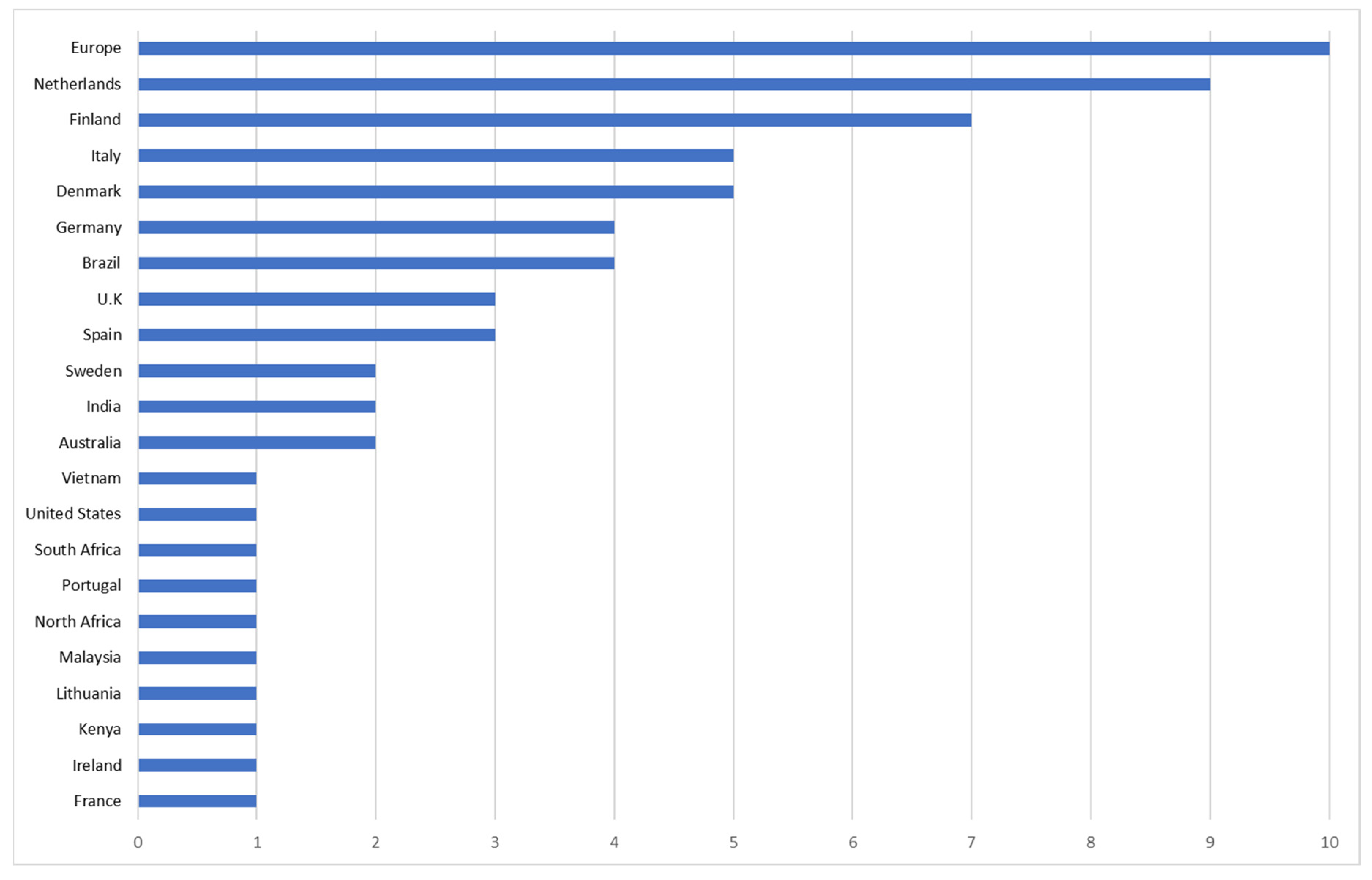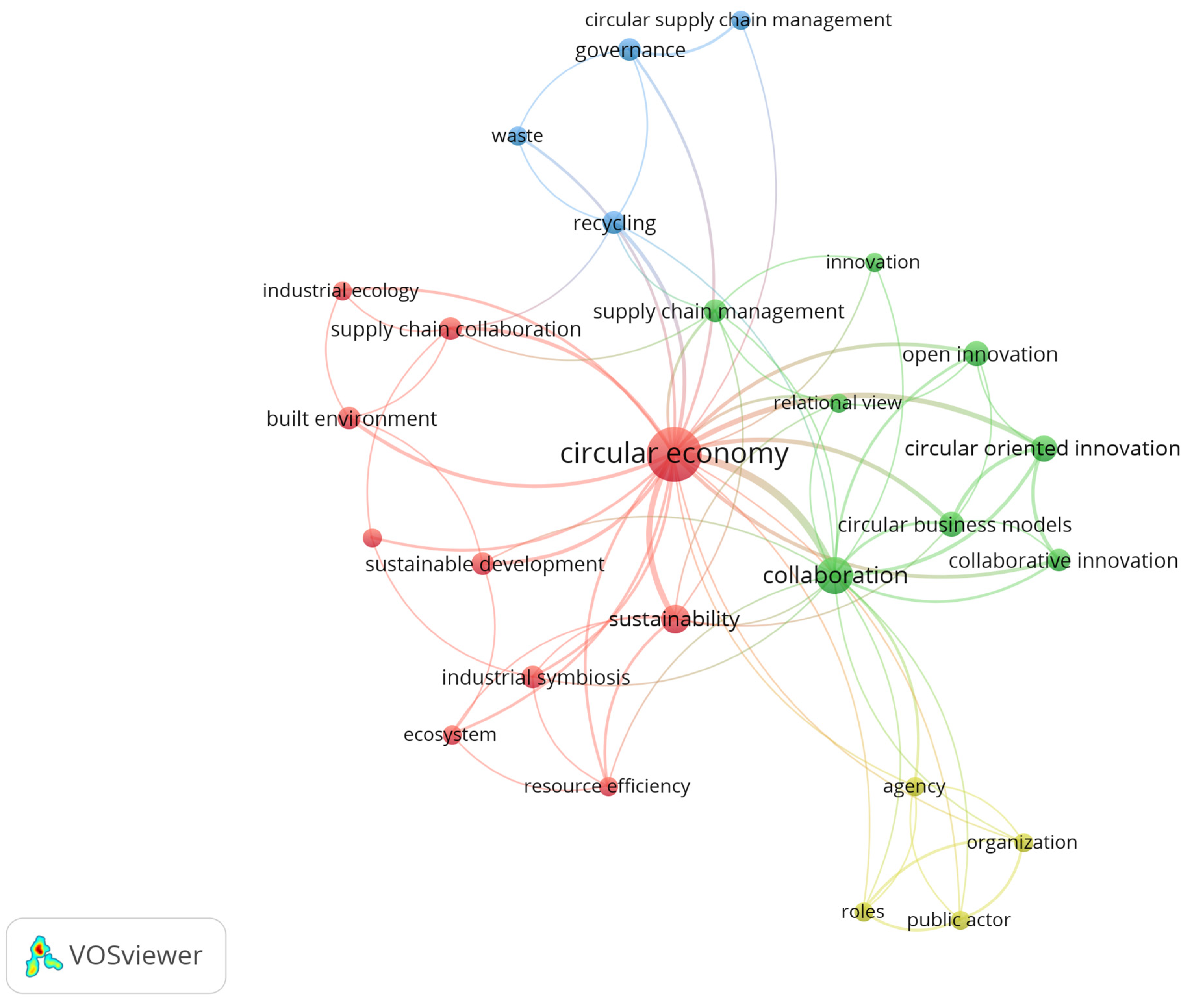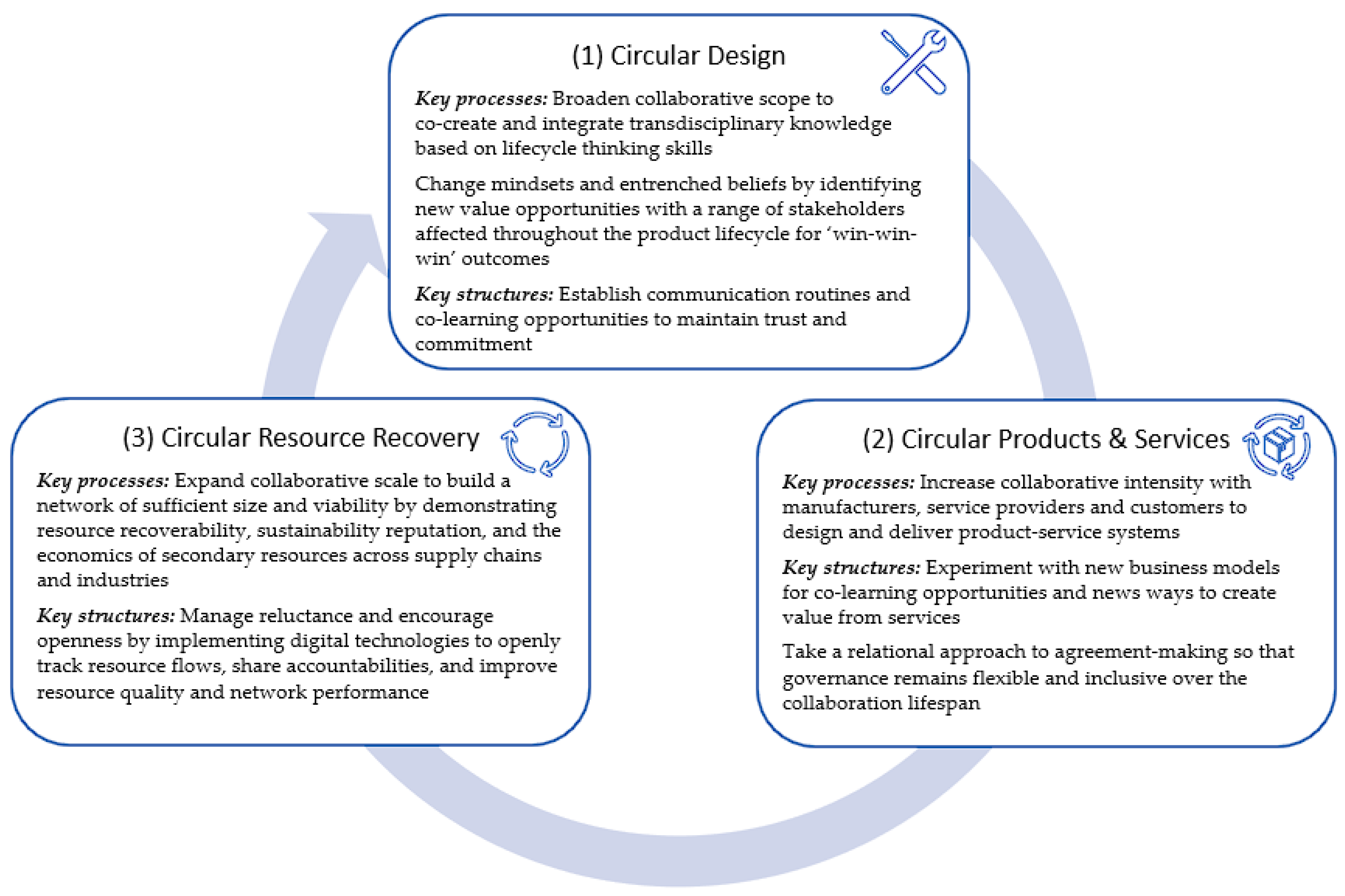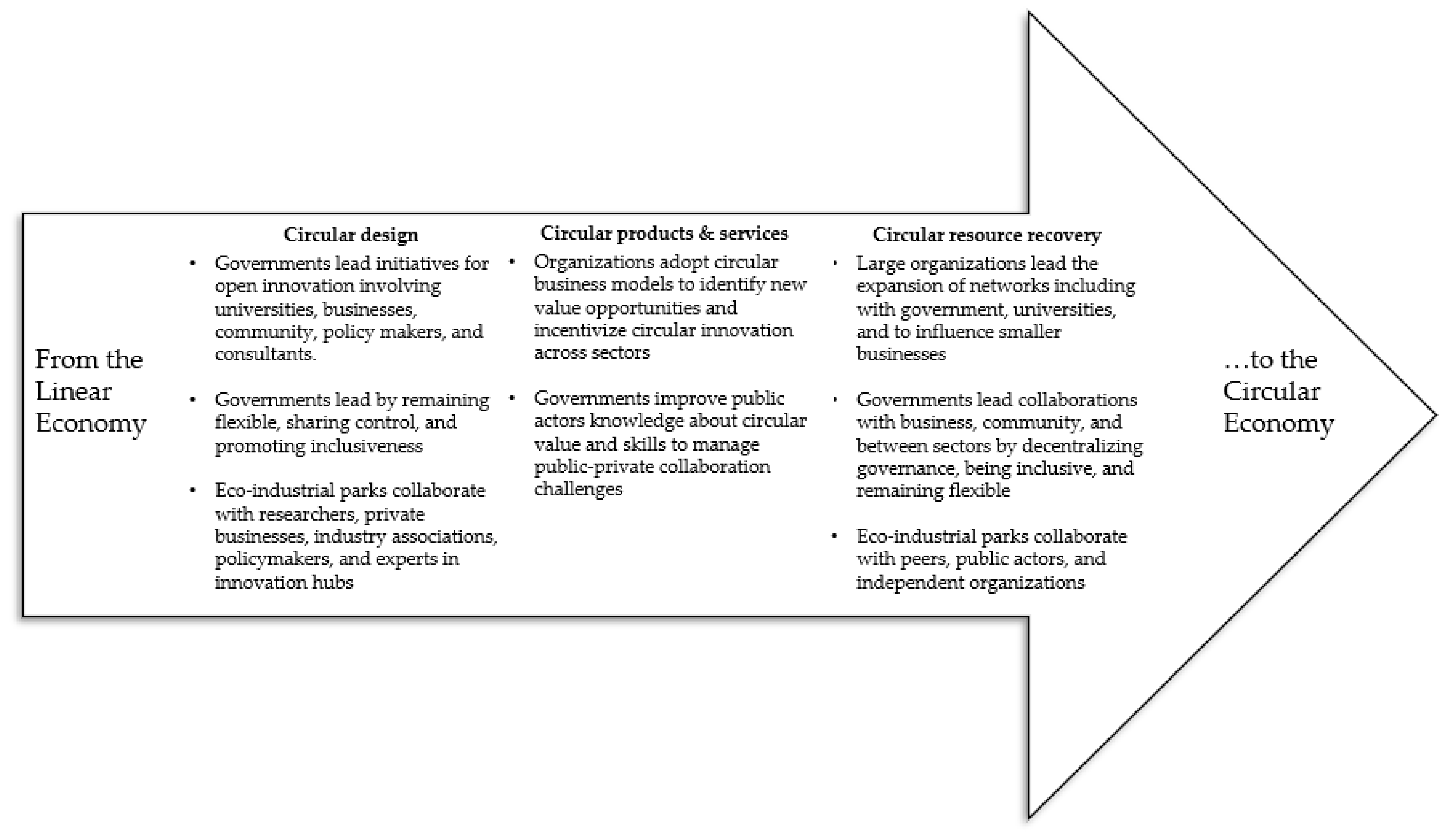Conceptualizing How Collaboration Advances Circularity
Abstract
:1. Introduction
A process in which autonomous or semi-autonomous actors interact through formal and informal negotiation, jointly creating rules and structures governing their relationships and ways to act or decide on the issues that brought them together; it is a process involving shared norms and mutually beneficial interactions.[12] (p. 25)
- How does collaboration advance circularity for organizations?
- What role does collaboration play in the transition from a linear economy to a circular economy?
1.1. Circularity and Collaboration in Organizations
1.2. The Role of Collaboration in Circularity
2. Methods
3. Descriptive Findings
3.1. Demographic Overview of the Publications
3.2. VOSviewer Bibliometric Analysis of Publications
4. Discussion of the Findings
4.1. Conceptualizing How Collaboration Advances Circularity
4.1.1. Circular Design
4.1.2. Circular Products and Services
4.1.3. Circular Resource Recovery
4.2. The Role of Collaboration in Transitioning from a Linear Economy to a Circular Economy
4.2.1. Multilevel Collaboration for Circular Design
4.2.2. Multilevel Collaboration for Circular Products and Services
4.2.3. Multilevel Collaboration for Circular Resource Recovery
4.3. Intermediaries to Accelerate CE Transitions
5. Conclusions
6. Limitations
7. Future Research
Author Contributions
Funding
Institutional Review Board Statement
Informed Consent Statement
Data Availability Statement
Conflicts of Interest
References
- Global Resources Outlook, 2019: Natural Resources for the Future We Want. Available online: https://www.resourcepanel.org/reports/global-resources-outlook (accessed on 20 January 2023).
- What Is the Circular Economy? Available online: https://ellenmacarthurfoundation.org/topics/circular-economy-introduction/overview (accessed on 20 January 2023).
- Bogers, M.; Chesbrough, H.; Strand, R.J. Sustainable open innovation to address a grand challenge: Lessons from Carlsberg and the Green Fiber Bottle. Br. Food J. 2020, 122, 1505–1517. [Google Scholar] [CrossRef]
- Geissdoerfer, M.; Savaget, P.; Bocken, N.M.; Hultink, E.J.J. The Circular Economy–A new sustainability paradigm? J. Clean. Prod. 2017, 143, 757–768. [Google Scholar] [CrossRef] [Green Version]
- Ghisellini, P.; Cialani, C.; Ulgiati, S. A review on circular economy: The expected transition to a balanced interplay of environmental and economic systems. J. Clean. Prod. 2016, 114, 11–32. [Google Scholar] [CrossRef]
- Kirchherr, J.; Piscicelli, L.; Bour, R.; Kostense-Smit, E.; Muller, J.; Huibrechtse-Truijens, A.; Hekkert, M.J. Barriers to the circular economy: Evidence from the European Union (EU). Ecol. Econ. 2018, 150, 264–272. [Google Scholar] [CrossRef] [Green Version]
- The Circularity Gap Report 2023. Available online: https://assets.website-files.com/5e185aa4d27bcf348400ed82/63c9411c827cc7b22366eade_CGR%202023%20-%20Report.pdf (accessed on 20 January 2023).
- Geissdoerfer, M.; Pieroni, M.P.P.; Pigosso, D.C.A.; Soufani, K. Circular business models: A review. J. Clean. Prod. 2020, 277, 123741. [Google Scholar] [CrossRef]
- Korhonen, J.; Nuur, C.; Feldmann, A.; Birkie, S.E. Circular economy as an essentially contested concept. J. Clean. Prod. 2018, 175, 544–552. [Google Scholar] [CrossRef]
- Chesbrough, H.J. The logic of open innovation: Managing intellectual property. Calif. Manag. Rev. 2003, 45, 33–58. [Google Scholar] [CrossRef]
- Gray, B.J. Conditions facilitating interorganizational collaboration. Hum. Relat. 1985, 38, 911–936. [Google Scholar] [CrossRef]
- Thomson, A.M.; Perry, J.L.; Miller, T.K.J. Conceptualizing and measuring collaboration. J. Public Admin. Res. 2009, 19, 23–56. [Google Scholar] [CrossRef] [Green Version]
- Blomsma, F.; Brennan, G.J. The emergence of circular economy: A new framing around prolonging resource productivity. J. Ind. Ecol. 2017, 21, 603–614. [Google Scholar] [CrossRef] [Green Version]
- Stahel, W.R.; MacArthur, E. The Circular Economy: A User’s Guide; Routledge: London, UK; New York, NY, USA, 2019; pp. 1–102. [Google Scholar]
- Urbinati, A.; Chiaroni, D.; Chiesa, V. Towards a new taxonomy of circular economy business models. J. Clean. Prod. 2017, 168, 487–498. [Google Scholar] [CrossRef]
- Bocken, N.M.P.; de Pauw, I.; Bakker, C.; van der Grinten, B. Product design and business model strategies for a circular economy. J. Ind. Prod. Eng. 2016, 33, 308–320. [Google Scholar] [CrossRef] [Green Version]
- Hofmann, F. Circular business models: Business approach as driver or obstructer of sustainability transitions? J. Clean. Prod. 2019, 224, 361–374. [Google Scholar] [CrossRef]
- Islam, M.; Iyer-Raninga, U.; Trewick, S. Recylcing perspectives of circular business models: A review. Recycling 2022, 7, 79. [Google Scholar] [CrossRef]
- Bressanelli, G.; Pigosso, D.C.A.; Saccani, N.; Perona, M. Enablers, levers and benefits of Circular Economy in the Electrical and Electronic Equipment supply chain: A literature review. J. Clean. Prod. 2021, 298, 126819. [Google Scholar] [CrossRef]
- Munaro, M.R.; Tavares, S.F.; Bragança, L. Towards circular and more sustainable buildings: A systematic literature review on the circular economy in the built environment. J. Clean. Prod. 2020, 260, 121134. [Google Scholar] [CrossRef]
- Chistov, V.; Aramburu, N.; Carrillo-Hermosilla, J. Open eco-innovation: A bibliometric review of emerging research. J. Clean. Prod. 2021, 311, 127627. [Google Scholar] [CrossRef]
- Jesus, G.M.K.; Jugend, D. How can open innovation contribute to circular economy adoption? Insights from a literature review. Europ. J. Inn. Manag. 2023, 26, 65–98. [Google Scholar] [CrossRef]
- Calicchio Berardi, P.; Peregrino de Brito, R. Supply chain collaboration for a circular economy—From transition to continuous improvement. J. Clean. Prod. 2021, 328, 129511. [Google Scholar] [CrossRef]
- De Angelis, R.; Howard, M.; Miemczyk, J. Supply chain management and the circular economy: Towards the circular supply chain. Prod. Plan. Cont. 2018, 29, 425–437. [Google Scholar] [CrossRef] [Green Version]
- Farooque, M.; Zhang, A.; Liu, Y. Barriers to circular food supply chains in China. Supply Chain Manag. Int. J. 2019, 24, 677–696. [Google Scholar] [CrossRef]
- Galvão, G.D.A.; Homrich, A.S.; Geissdoerfer, M.; Evans, S.; Ferrer, P.S.s.; Carvalho, M.M. Towards a value stream perspective of circular business models. Resour. Conserv. Recyl. 2020, 162, 105060. [Google Scholar] [CrossRef]
- Hansen, E.G.; Revellio, F. Circular value creation architectures: Make, ally, buy, or laissez-faire. J. Ind. Ecol. 2020, 24, 1250–1273. [Google Scholar] [CrossRef]
- Konietzko, J.; Bocken, N.; Hultink, E.J. Circular ecosystem innovation: An initial set of principles. J. Clean. Prod. 2020, 253, 119942. [Google Scholar] [CrossRef]
- Ruggieri, A.; Braccini, A.M.; Poponi, S.; Mosconi, E.M. A Meta-Model of Inter-Organisational Cooperation for the Transition to a Circular Economy. Sustainability 2016, 8, 1153. [Google Scholar] [CrossRef] [Green Version]
- Geng, Y.; Doberstein, B. Developing the circular economy in China: Challenges and opportunities for achieving ‘leapfrog development’. Int. J. Sust. Dev. World Ecol. 2008, 15, 231–239. [Google Scholar] [CrossRef] [Green Version]
- Adams, R.; Jeanrenaud, S.; Bessant, J.; Denyer, D.; Overy, P. Sustainability-oriented Innovation: A Systematic Review. Int. J. Manag. Rev. 2016, 18, 180–205. [Google Scholar] [CrossRef] [Green Version]
- Szekely, F.; Strebel, H. Incremental, radical and game-changing: Strategic innovation for sustainability. Corp. Gov. 2013, 13, 467–481. [Google Scholar] [CrossRef]
- McDonough, W.; Braungart, M. Design for the Triple Top Line: New Tools for Sustainable Commerce. Corp. Environ. Strategy 2002, 9, 251–258. [Google Scholar] [CrossRef]
- Osterwalder, A.; Pigneur, Y. Business Model Generation: A Handbook for Visionaries, Game Changers, and Challengers; John Wiley & Sons: Hoboken, NJ, USA, 2010; pp. 1–286. [Google Scholar]
- Teece, D.J. Business Models, Business Strategy and Innovation. Long Range Plan. 2010, 43, 172–194. [Google Scholar] [CrossRef]
- Bocken, N.M.P.; Short, S.W. Towards a sufficiency-driven business model: Experiences and opportunities. Environ. Innov. Soc. Trans. 2016, 18, 41–61. [Google Scholar] [CrossRef] [Green Version]
- Wells, P.; Seitz, M. Business models and closed-loop supply chains: A typology. Supply Chain. Manag. Int. J. 2005, 10, 249–251. [Google Scholar] [CrossRef]
- Raddats, C.; Kowalkowski, C.; Benedettini, O.; Burton, J.; Gebauer, H. Servitization: A contemporary thematic review of four major research streams. Ind. Mark. Manag. 2019, 83, 207–223. [Google Scholar] [CrossRef]
- Kristensen, H.S.; Remmen, A. A framework for sustainable value propositions in product-service systems. J. Clean. Prod. 2019, 223, 25–35. [Google Scholar] [CrossRef]
- Gulati, R.; Wohlgezogen, F.; Zhelyazkov, P. The Two Facets of Collaboration: Cooperation and Coordination in Strategic Alliances. Acad. Manag. Ann. 2012, 6, 531–583. [Google Scholar] [CrossRef]
- Thomson, A.M.; Perry, J.L. Collaboration Processes: Inside the Black Box. Pub. Admin. Rev. 2006, 66, 20–32. [Google Scholar] [CrossRef]
- Bryson, J.M.; Crosby, B.C.; Stone, M.M. Designing and Implementing Cross-Sector Collaborations: Needed and Challenging. Pub. Admin. Rev. 2015, 75, 647–663. [Google Scholar] [CrossRef]
- Huxham, C.; Vangen, S. Working together. Int. J. Pub. Sector Manag. 1996, 9, 5–17. [Google Scholar] [CrossRef]
- Dyer, J.H.; Singh, H. The Relational View: Cooperative Strategy and Sources of Interorganizational Competitive Advantage. Acad. Manag. Rev. 1998, 23, 660–679. [Google Scholar] [CrossRef]
- Das, T.K.; Teng, B.-S. Sustaining Strategic Alliances: Options and Guidelines. J. Gen. Manag. 1997, 22, 49–64. [Google Scholar] [CrossRef]
- Ring, P.S.; Van De Ven, A.H. Developmental Processes of Cooperative Interorganizational Relationships. Acad. Manag. Rev. 1994, 19, 90–118. [Google Scholar] [CrossRef]
- Gulati, R. Alliances and networks. Strat. Manag. J. 1998, 19, 293–317. [Google Scholar] [CrossRef]
- Huxham, C.; Vangen, S. Leadership in the Shaping and Implementation Of Collaboration Agendas: How Things Happen in a (Not Quite) Joined-Up World. Acad. Manag. J. 2000, 43, 1159–1175. [Google Scholar] [CrossRef]
- Kale, P.; Singh, H. Building firm capabilities through learning: The role of the alliance learning process in alliance capability and firm-level alliance success. Strat. Manag. J. 2007, 28, 981–1000. [Google Scholar] [CrossRef] [Green Version]
- Majchrzak, A.; Jarvenpaa, S.L.; Bagherzadeh, M. A Review of Interorganizational Collaboration Dynamics. J. Manag. 2014, 41, 1338–1360. [Google Scholar] [CrossRef]
- Bocken, N.; Ritala, P. Six ways to build circular business models. J. Bus. Strategy 2022, 43, 184–192. [Google Scholar] [CrossRef]
- Korhonen, J.; Honkasalo, A.; Seppälä, J. Circular Economy: The Concept and its Limitations. Ecol. Econ. 2018, 143, 37–46. [Google Scholar] [CrossRef]
- Kirchherr, J.; Reike, D.; Hekkert, M. Conceptualizing the circular economy: An analysis of 114 definitions. Resour. Conserv. Recycl. 2017, 127, 221–232. [Google Scholar] [CrossRef]
- Tranfield, D.; Denyer, D.; Smart, P. Towards a Methodology for Developing Evidence-Informed Management Knowledge by Means of Systematic Review. Br. J. Manag. 2003, 14, 207–222. [Google Scholar] [CrossRef]
- Morales, M.E.; Batlles-delaFuente, A.; Cortés-García, F.J.; Belmonte-Ureña, L.J. Theoretical Research on Circular Economy and Sustainability Trade-Offs and Synergies. Sustainability 2021, 13, 11636. [Google Scholar] [CrossRef]
- Mattessich, P.W.; Murray-Close, M.; Monsey, B.J.W.F. Collaboration: What Makes It Work; Amherst H: Sanit Paril, MN, USA, 2001; pp. 3–57. [Google Scholar]
- Circular Economy Action Plan. Available online: https://environment.ec.europa.eu/strategy/circular-economy-action-plan_en (accessed on 6 January 2023).
- van Eck, N.; Waltman, L. Software survey: VOSviewer, a computer program for bibliometric mapping. Scientometrics 2010, 84, 523–538. [Google Scholar] [CrossRef] [PubMed] [Green Version]
- Zupic, I.; Čater, T. Bibliometric Methods in Management and Organization. Org. Res. Meth. 2014, 18, 429–472. [Google Scholar] [CrossRef]
- Brown, P.; Bocken, N.; Balkenende, R. How Do Companies Collaborate for Circular Oriented Innovation? Sustainability 2020, 12, 1648. [Google Scholar] [CrossRef] [Green Version]
- Brown, P.; Von Daniels, C.; Bocken, N.M.P.; Balkenende, A.R. A process model for collaboration in circular oriented innovation. J. Clean. Prod. 2021, 286, 125499. [Google Scholar] [CrossRef]
- Hansen, E.G.; Schmitt, J.C. Orchestrating cradle-to-cradle innovation across the value chain: Overcoming barriers through innovation communities, collaboration mechanisms, and intermediation. J. Ind. Ecol. 2021, 25, 627–647. [Google Scholar] [CrossRef]
- Leising, E.; Quist, J.; Bocken, N. Circular Economy in the building sector: Three cases and a collaboration tool. J. Clean. Prod. 2018, 176, 976–989. [Google Scholar] [CrossRef]
- Goldsworthy, K.; Ellams, D.J.T.D.J. Collaborative circular design. Incorporating life cycle thinking into an interdisciplinary design process. Des. J. 2019, 22, 1041–1055. [Google Scholar] [CrossRef] [Green Version]
- Eisenreich, A.; Füller, J.; Stuchtey, M. Open Circular Innovation: How Companies Can Develop Circular Innovations in Collaboration with Stakeholders. Sustainability 2021, 13, 13456. [Google Scholar] [CrossRef]
- Köhler, J.; Sönnichsen, S.D.; Beske-Jansen, P. Towards a collaboration framework for circular economy: The role of dynamic capabilities and open innovation. Bus. Strategy Environ. 2022, 31, 2700–2713. [Google Scholar] [CrossRef]
- Krmela, A.; Šimberová, I.; Babiča, V. Dynamics of Business Models in Industry-Wide Collaborative Networks for Circularity. J. Open Innov. Technol. Mark. Compl. 2022, 8, 3. [Google Scholar] [CrossRef]
- Franco, M.A. Circular economy at the micro level: A dynamic view of incumbents’ struggles and challenges in the textile industry. J. Clean. Prod. 2017, 168, 833–845. [Google Scholar] [CrossRef]
- Cricelli, L.; Greco, M.; Grimaldi, M. An investigation on the effect of inter-organizational collaboration on reverse logistics. Int.J. Prod. Econ. 2021, 240, 108216. [Google Scholar] [CrossRef]
- Bertassini, A.C.; Zanon, L.G.; Azarias, J.G.; Gerolamo, M.C.; Ometto, A.R. Circular Business Ecosystem Innovation: A guide for mapping stakeholders, capturing values, and finding new opportunities. Sust. Prod. Consum. 2021, 27, 436–448. [Google Scholar] [CrossRef]
- Veleva, V.; Bodkin, G. Corporate-entrepreneur collaborations to advance a circular economy. J. Clean. Prod. 2018, 188, 20–37. [Google Scholar] [CrossRef]
- Chirumalla, K.; Reyes, L.G.; Toorajipour, R. Mapping a circular business opportunity in electric vehicle battery value chain: A multi-stakeholder framework to create a win–win–win situation. J. Bus. Res. 2022, 145, 569–582. [Google Scholar] [CrossRef]
- Cantele, S.; Moggi, S.; Campedelli, B. Spreading Sustainability Innovation through the Co-Evolution of Sustainable Business Models and Partnerships. Sustainability 2020, 12, 1190. [Google Scholar] [CrossRef] [Green Version]
- Trevisan, A.H.; Castro, C.G.; Gomes, L.A.V.; Mascarenhas, J. Unlocking the circular ecosystem concept: Evolution, current research, and future directions. Sust. Prod. Consum. 2022, 29, 286–298. [Google Scholar] [CrossRef]
- Brown, P.; Baldassarre, B.; Konietzko, J.; Bocken, N.; Balkenende, R. A tool for collaborative circular proposition design. J. Clean. Prod. 2021, 297, 126354. [Google Scholar] [CrossRef]
- Bakırlıoğlu, Y.; McMahon, M. Co-learning for sustainable design: The case of a circular design collaborative project in Ireland. J. Clean. Prod. 2021, 279, 123474. [Google Scholar] [CrossRef]
- Tseng, M.-L.; Ha, H.M.; Wu, K.-J.; Xue, B. Healthcare industry circular supply chain collaboration in Vietnam: Vision and learning influences on connection in a circular supply chain and circularity business model. Int. J. Log. Res. Appl. 2022, 25, 743–768. [Google Scholar] [CrossRef]
- Mishra, J.L.; Chiwenga, K.D.; Ali, K. Collaboration as an enabler for circular economy: A case study of a developing country. Manag. Dec. 2021, 59, 1784–1800. [Google Scholar] [CrossRef]
- Zucchella, A.; Previtali, P. Circular business models for sustainable development: A “waste is food” restorative ecosystem. Bus. Strategy Environ. 2019, 28, 274–285. [Google Scholar] [CrossRef]
- Hornbuckle, R. Mobilizing Materials Knowledge: Exploring the Role of Samples for Supporting Multidisciplinary Collaborative Design for Materials Development. Des. J. 2021, 24, 277–297. [Google Scholar] [CrossRef]
- Herczeg, G.; Akkerman, R.; Hauschild, M.Z. Supply chain collaboration in industrial symbiosis networks. J. Clean. Prod. 2018, 171, 1058–1067. [Google Scholar] [CrossRef] [Green Version]
- Brown, P.; Bocken, N.; Balkenende, R. Why Do Companies Pursue Collaborative Circular Oriented Innovation? Sustainability 2019, 11, 635. [Google Scholar] [CrossRef] [Green Version]
- Tushman, M.L.; O’Reilly, C.A., III. Ambidextrous organizations: Managing evolutionary and revolutionary change. Calif. Manag. Rev. 1996, 38, 8–29. [Google Scholar] [CrossRef] [Green Version]
- Fischer, A.; Pascucci, S. Institutional incentives in circular economy transition: The case of material use in the Dutch textile industry. J. Clean. Prod. 2017, 155, 17–32. [Google Scholar] [CrossRef] [Green Version]
- Ho, C.-H.; Böhm, S.; Monciardini, D. The collaborative and contested interplay between business and civil society in circular economy transitions. Bus. Strategy Environ. 2022, 31, 2714–2727. [Google Scholar] [CrossRef]
- Martina, R.A.; Oskam, I.F. Practical guidelines for designing recycling, collaborative, and scalable business models: A case study of reusing textile fibers into biocomposite products. J. Clean. Prod. 2021, 318, 128542. [Google Scholar] [CrossRef]
- Oliveira Silva, W.D.; Morais, D.C. Transitioning to a circular economy in developing countries: A collaborative approach for sharing responsibilities in solid waste management of a Brazilian craft brewery. J. Clean. Prod. 2021, 319, 128703. [Google Scholar] [CrossRef]
- Schultz, F.C.; Everding, S.; Pies, I. Circular supply chain governance: A qualitative-empirical study of the European polyurethane industry to facilitate functional circular supply chain management. J. Clean. Prod. 2021, 317, 128445. [Google Scholar] [CrossRef]
- Bloise, C. Collaboration in a circular economy. J. Ent. Inform. Manag. 2020, 33, 769–789. [Google Scholar] [CrossRef]
- Prieto-Sandoval, V.; Mejia-Villa, A.; Jaca, C.; Ormazabal, M. The Case of an Agricultural Crop Business Association in Navarra as Circular Economy Intermediary. Circ. Econ. Sust. 2022, 2, 713–729. [Google Scholar] [CrossRef] [PubMed]
- Kleine Jäger, J.; Piscicelli, L. Collaborations for circular food packaging: The set-up and partner selection process. Sust. Prod. Consum. 2021, 26, 733–740. [Google Scholar] [CrossRef]
- Luthra, S.; Sharma, M.; Kumar, A.; Joshi, S.; Collins, E.; Mangla, S. Overcoming barriers to cross-sector collaboration in circular supply chain management: A multi-method approach. Trans. Res. Part E Log. Trans. Rev. 2022, 157, 102582. [Google Scholar] [CrossRef]
- Pereira, Á.; Vence, X. The role of KIBS and consultancy in the emergence of Circular Oriented Innovation. J. Clean. Prod. 2021, 302, 127000. [Google Scholar] [CrossRef]
- Rincón-Moreno, J.; Ormazabal, M.; Álvarez, M.J.; Jaca, C. Shortcomings of Transforming a Local Circular Economy System through Industrial Symbiosis: A Case Study in Spanish SMEs. Sustainability 2020, 12, 8423. [Google Scholar] [CrossRef]
- de Oliveira Neto, G.C.; da Conceição Silva, A.; Filho, M.G. How can Industry 4.0 technologies and circular economy help companies and researchers collaborate and accelerate the transition to strong sustainability? A bibliometric review and a systematic literature review. Int. J. Environ. Sci. Technol. 2022, 20, 3483–3520. [Google Scholar] [CrossRef]
- Bag, S.; Rahman, M.S. The role of capabilities in shaping sustainable supply chain flexibility and enhancing circular economy-target performance: An empirical study. Supply Chain Manag. Int. J. 2023, 28, 162–178. [Google Scholar] [CrossRef]
- Brown, P.J.; Bajada, C. An economic model of circular supply network dynamics: Toward an understanding of performance measurement in the context of multiple stakeholders. Bus. Strategy Environ. 2018, 27, 643–655. [Google Scholar] [CrossRef]
- Ciccullo, F.; Cagliano, R.; Bartezzaghi, G.; Perego, A. Implementing the circular economy paradigm in the agri-food supply chain: The role of food waste prevention technologies. Resour. Conser. Recycl. 2021, 164, 105114. [Google Scholar] [CrossRef]
- Gebhardt, M.; Kopyto, M.; Birkel, H.; Hartmann, E. Industry 4.0 technologies as enablers of collaboration in circular supply chains: A systematic literature review. Int.J. Prod. Res. 2022, 60, 6967–6995. [Google Scholar] [CrossRef]
- Gupta, S.; Chen, H.; Hazen, B.T.; Kaur, S.; Santibañez Gonzalez, E.D.R. Circular economy and big data analytics: A stakeholder perspective. Technol. Forecast. Soc. Chang. 2019, 144, 466–474. [Google Scholar] [CrossRef]
- Ellsworth-Krebs, K.; Rampen, C.; Rogers, E.; Dudley, L.; Wishart, L. Circular economy infrastructure: Why we need track and trace for reusable packaging. Sust. Prod. Consum. 2022, 29, 249–258. [Google Scholar] [CrossRef]
- Bakırlıoğlu, Y.; Terzioğlu, N.; Celik, S.; Ulan, A.; Segalas, J. Selection and framing of briefs for educational circular design projects. Int.J. Sust. High. Ed. 2021, 22, 1125–1144. [Google Scholar] [CrossRef]
- Engez, A.; Leminen, S.; Aarikka-Stenroos, L. Urban Living Lab as a Circular Economy Ecosystem: Advancing Environmental Sustainability through Economic Value, Material, and Knowledge Flows. Sustainability 2021, 13, 2811. [Google Scholar] [CrossRef]
- Cuomo, F. Urban Living Lab: An Experimental Co-Production Tool to Foster the Circular Economy. Soc. Sci. 2022, 11, 260. [Google Scholar] [CrossRef]
- Cerreta, M.; Elefante, A.; La Rocca, L. A Creative Living Lab for the Adaptive Reuse of the Morticelli Church: The SSMOLL Project. Sustainability 2020, 12, 10561. [Google Scholar] [CrossRef]
- Meath, C.; Karlovšek, J.; Navarrete, C.; Eales, M.; Hastings, P. Co-designing a multi-level platform for industry level transition to circular economy principles: A case study of the infrastructure CoLab. J. Clean. Prod. 2022, 347, 131080. [Google Scholar] [CrossRef]
- Ingio, E.; Albareda, L.; Ritala, P. Business model innovation for sustainability: Exploring evolutionary and radical approaches through dynamic capabilities. Ind. Innov. 2017, 24, 515–542. [Google Scholar] [CrossRef]
- Witjes, S.; Lozano, R. Towards a more Circular Economy: Proposing a framework linking sustainable public procurement and sustainable business models. Resour. Conserv. Recycl. 2016, 112, 37–44. [Google Scholar] [CrossRef] [Green Version]
- Bocken, N.; Short, S.; Rana, P.; Evans, S. A value mapping tool for sustainable business modelling. Corp. Gov. 2013, 13, 482–497. [Google Scholar] [CrossRef]
- Porter, M.E.; Kramer, M.R.J.H.B.R. Creating shared value: Redefining capitalism and the role of the corporation in society. Harv. Bus. Rev. 2011, 89, 62–77. [Google Scholar]
- Stubbs, W.; Cocklin, C. Conceptualizing a “Sustainability Business Model”. Org. Environ. 2008, 21, 103–127. [Google Scholar] [CrossRef]
- Kristensen, H.S.; Mosgaard, M.A.; Remmen, A. Circular public procurement practices in Danish municipalities. J. Clean. Prod. 2021, 281, 124962. [Google Scholar] [CrossRef]
- Hirvensalo, A.; Teerikangas, S.; Reynolds, N.-S.; Kalliomäki, H.; Mäntysalo, R.; Mattila, H.; Granqvist, K. Agency in Circular City Ecosystems—A Rationalities Perspective. Sustainability 2021, 13, 2544. [Google Scholar] [CrossRef]
- Ingstrup, M.B.; Aarikka-Stenroos, L.; Adlin, N. When institutional logics meet: Alignment and misalignment in collaboration between academia and practitioners. Ind. Mark. Manag. 2021, 92, 267–276. [Google Scholar] [CrossRef]
- Ddiba, D.; Andersson, K.; Koop, S.H.A.; Ekener, E.; Finnveden, G.; Dickin, S. Governing the circular economy: Assessing the capacity to implement resource-oriented sanitation and waste management systems in low- and middle-income countries. Earth Sys. Gov. 2020, 4, 100063. [Google Scholar] [CrossRef]
- Owojori, O.M.; Okoro, C. The Private Sector Role as a Key Supporting Stakeholder towards Circular Economy in the Built Environment: A Scientometric and Content Analysis. Buildings 2022, 12, 695. [Google Scholar] [CrossRef]
- Christensen, T.B. Towards a circular economy in cities: Exploring local modes of governance in the transition towards a circular economy in construction and textile recycling. J. Clean. Prod. 2021, 305, 127058. [Google Scholar] [CrossRef]
- Uusikartano, J.; Väyrynen, H.; Aarikka-Stenroos, L. Public Agency in Changing Industrial Circular Economy Ecosystems: Roles, Modes and Structures. Sustainability 2020, 12, 10015. [Google Scholar] [CrossRef]
- Uusikartano, J.; Väyrynen, H.; Aarikka-Stenroos, L. Public actors and their diverse roles in eco-industrial parks: A multiple-case study. J. Clean. Prod. 2021, 296, 126463. [Google Scholar] [CrossRef]
- Patala, S.; Salmi, A.; Bocken, N. Intermediation dilemmas in facilitated industrial symbiosis. J. Clean. Prod. 2020, 261, 121093. [Google Scholar] [CrossRef]
- Berlin, D.; Feldmann, A.; Nuur, C. Supply network collaborations in a circular economy: A case study of Swedish steel recycling. Resour. Conserv. Recycl. 2022, 179, 106112. [Google Scholar] [CrossRef]
- Geissdoerfer, M.; Morioka, S.N.; de Carvalho, M.M.; Evans, S. Business models and supply chains for the circular economy. J. Clean. Prod. 2018, 190, 712–721. [Google Scholar] [CrossRef]
- González-Moreno, Á.; Triguero, Á.; Sáez-Martínez, F.J. Many or trusted partners for eco-innovation? The influence of breadth and depth of firms’ knowledge network in the food sector. Technol. Forecast. Soc. Chang. 2019, 147, 51–62. [Google Scholar] [CrossRef]







| Inclusion Criteria | Exclusion Criteria |
|---|---|
| Must explicitly address circular economy (e.g., circularity, circular business models, circular-oriented innovation, circular bioeconomy, circular design, circular supply chains, or circular networks, etc.) | Does not explicitly address circular economy (e.g., instead, only addresses CSR, sustainability, eco-innovation, industrial symbiosis, waste management, etc.) |
| Must explicitly address collaboration theoretically, conceptually, or empirically in the literature review, conceptual background, or methods sections. | Does not substantively address collaboration theoretically, conceptually, or empirically in the literature review, conceptual background, or methods sections (e.g., only in the introduction, findings, and/or in a normative way) |
Disclaimer/Publisher’s Note: The statements, opinions and data contained in all publications are solely those of the individual author(s) and contributor(s) and not of MDPI and/or the editor(s). MDPI and/or the editor(s) disclaim responsibility for any injury to people or property resulting from any ideas, methods, instructions or products referred to in the content. |
© 2023 by the authors. Licensee MDPI, Basel, Switzerland. This article is an open access article distributed under the terms and conditions of the Creative Commons Attribution (CC BY) license (https://creativecommons.org/licenses/by/4.0/).
Share and Cite
Danvers, S.; Robertson, J.; Zutshi, A. Conceptualizing How Collaboration Advances Circularity. Sustainability 2023, 15, 5553. https://doi.org/10.3390/su15065553
Danvers S, Robertson J, Zutshi A. Conceptualizing How Collaboration Advances Circularity. Sustainability. 2023; 15(6):5553. https://doi.org/10.3390/su15065553
Chicago/Turabian StyleDanvers, Stuart, Jonathan Robertson, and Ambika Zutshi. 2023. "Conceptualizing How Collaboration Advances Circularity" Sustainability 15, no. 6: 5553. https://doi.org/10.3390/su15065553






